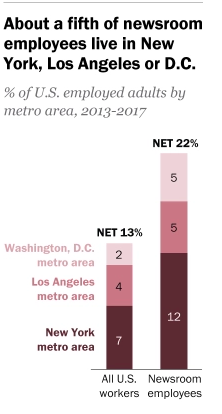Everyone is glued to the news these days. Between coronavirus, racial unrest and the biggest election of our lifetimes, there’s no shortage of hard news to read each and every day. But, that doesn’t mean journalism is thriving again. In many ways, the situation is more dire than ever. Trust levels remain low. Media outlets are fragmented and politcized. And revenue continues to struggle.
And, all that has big ramifications for those of us in the PR industry. Today I thought I’d take a look at some of the macro-level trends happening in the media industry and their impact on us, as PR professionals, in the coming years.
Trend #1: Newsrooms are more barren than ever.
Supporting stat: Newsroom employment in the U.S. dropped by 23% between 2008 and 2019.

Impact: This continues a trend, as you can see from the graphic above, that we’ve been witnessing now for 10+ years. It seems to have plateaued, but newsrooms are thinly staffed at best. For PRs, that means supplying more content to our media friends. In some cases, it means pitching bylines instead of stories. In others, it means supplying them with photography and videos when you can. Bottom line: Make sure you almost always have content to offer up journalists, who are in more dire need of it now than ever.
Trend #2: Big-time news is increasingly reported from one of three cities.
Supporting stat: One-in-five newsroom employees live in New York, Los Angeles or Washington, D.C.

Impact: One translation of these stats is “consolidation.” And, that wouldn’t be wrong. More consolidation means fewer outlets to pitch, which we have definitely seen in recent years. Also, the notion of deskside briefings or actually meeting your media partners may be a thing of the past–and definitely will be for the foreseeable future with COVID (unless you live in New York, Washington D.C. or LA). So, finding ways to cement relationships virtually will be more important than ever. From recent reports, reporters still like to communicate via email with PRs, but maybe you sprinkle in a phone call once in a while, or a Zoom call. After all, reporters are human, too. They’re craving interactions. A simple, 10 minute phone call might go a long way in developing that relationship right now!
Trend #3: The problem of the paywall.
Supporting stat: According to the study by Felix Simon and Lucas Graves, more than two-thirds of leading newspapers (69%) across the EU and US were operating some kind of online paywall as of 2019, a trend that has increased since 2017 according to the researchers, with the US seeing an increase from 60% to 76%.
Impact: I’ve been harping on this one for years–because it’s a BIG deal for PRs. With the majority of newspapers now having paywalls (and more trade pubs every day), the reach of that story you just got placed is extremely limited. As in, limited to paying readers of the publication. That means, no sharing on social (even though we see that all the time–super frustrating for readers!). And, it also means no sharing anywhere else you’d like to–enewsletters, your intranet or in sales materials (not unless you flip for the PDF, which will cost you many thousands of dollars in some cases). The paywall is a big problem. As a fan of journalism, I’m all for paywalls. But, as a PR, it’s a huge obstacle. Huge.
Trend #4: Local news has a capital shortage.
Supporting quote: “There may not be enough philanthropic capital, even on the sidelines, to support the scope and depth of local news-gathering that our democracy requires.”
Impact: This comes to no surprise to anyone who follows local news. Newspapers are struggling. Local TV stations, too. And, to date, to shore up those gaps, they’ve turned to philanthropic partners. But, is that sustainable? Will it last? Those are the big questions this Nieman Lab article explores, and they’re interesting for anyone who cares about local news. On the PR front, this could mean a big change in how (and if) we pitch local news. With more consolidation, you see local news running more stories from the network. That trend will probably continue. Real, feet-on-the-ground reporting is tougher to come by. We need to adjust our plans accordingly.

0 Comments